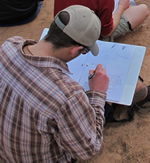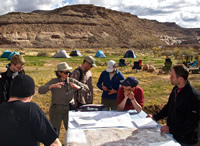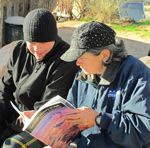Water, sustainability, creativity, inspiration: The U of U’s multifaceted field center.
~It should be about a 75-minute drive from Moab, but by the time you reach the small “Rio Mesa” sign, you have already stopped several times to look at jaw-dropping scenery that includes fluffy pink, chocolate swirled, whipped cream-topped rocks as big as buildings.
The unfolding of this stunning landscape prepares you for the sense of wonder and possibility to be experienced a half-mile ahead, where the road dips down to the banks of the Dolores River on the Colorado Plateau.
 Rio Mesa (formerly called the Entrada Field Station), which the University of Utah established in 2008, consists of 380 acres along nearly three miles of the Dolores River, structures dating from the 1870s, a 60-year-old USGS water-monitoring station, tamarisk trees, and old mining equipment, all surrounded by spectacular box canyons.
Rio Mesa (formerly called the Entrada Field Station), which the University of Utah established in 2008, consists of 380 acres along nearly three miles of the Dolores River, structures dating from the 1870s, a 60-year-old USGS water-monitoring station, tamarisk trees, and old mining equipment, all surrounded by spectacular box canyons.
It is becoming one of the U’s most exciting projects: a remote but easily accessible treasure of nature, a magical place that draws people from all disciplines to consider questions that arise naturally in this environment—questions regarding water, preservation, history, sustainability—and to collaborate to find solutions to the challenges of the upcoming decades.
At Rio Mesa, research, instruction, artistic interpretation, and professional training emanate from a common feeling of concern and interest—and the work looks a lot more like fun. Rio Mesa has great potential to advance the U’s mission in the areas of engagement with southeastern Utah, interdisciplinary experience, and the integration of instruction and research.
Afternoon at Rio Mesa
 Just past a 1950s-era pickup truck, the dirt road smoothes into concrete slabs leading down, through, and up the side of a creek bed. Polka-dotted straw matting covers the dirt banks. Civil engineering undergrad students at the U designed this crossing to prevent road washout during storms.
Just past a 1950s-era pickup truck, the dirt road smoothes into concrete slabs leading down, through, and up the side of a creek bed. Polka-dotted straw matting covers the dirt banks. Civil engineering undergrad students at the U designed this crossing to prevent road washout during storms.
This is one of many Rio Mesa projects researched and designed by U students. Forty-six students from six disciplines participated in creating Rio Mesa’s master plan. In 2010, civil engineering graduate students undertook a flood-plain analysis and road improvements. A student from the Department of Parks, Recreation, and Tourism designed an interpretive trail. This particular week, students in Biomimicry, a graduate class co-taught through the College of Architecture and the Department of Biology, are studying designs found in nature and how they can be translated into human-built structures. Two MUSE (My University Signature Experience—see the Spring 2011 issue of Continuum) scholars are assessing the viability of restoring or salvaging wood from a 1970s barn; architectural students are researching the design and construction of a bathhouse. Alternative Spring Break students are analyzing and documenting the site’s two 1880s-period homestead buildings. And last fall, more than 20 Alternative Fall Break students from the U’s Bennion Center worked to restore the center’s ailing orchard.
“No other field station has gotten students involved in its development like this,” says Sylvia Torti PhD’98, the manager of Rio Mesa, who is working at her laptop in the Dalton House’s small communal kitchen, which, as the only indoor gathering spot, has become the heart of the center.
Torti, who has taught biology and creative writing at the U, is the perfect model for the kind of interdisciplinary scholar Rio Mesa attracts. An Argentine-American, Torti is not only a research biologist with a specialty in migratory birds but also a prize-winning novelist. Torti, who credits U of U Professor of Biology Jim Ehleringer with first seeing Rio Mesa’s potential, envisions the site as a unique place that will provide opportunities for research, education, art, and professional development to anyone “whose future,” she says, “will require environmental literacy.” Few field stations attempt this level of disciplinary integration. Vice President for Research Tom Parks, who oversees Rio Mesa, agrees. “We are trying to create a distinctive built environment to foster multidisciplinary research, teaching, and artistic activities in a harsh natural environment with a unique beauty and human history,” he says.
The kind of research Rio Mesa sparks is the kind that feels effortless, like counting the ants crawling over your leg when you were a kid enjoying a long summer day with no school. In fact, counting ants was one of the first research projects undertaken at Rio Mesa. Biology Professor Don Feener and a group of K-12 teachers from around the state mapped two species of seed harvester ants that compete for food.
Ryan Smith, associate professor of architecture and Rio Mesa’s research director, says Rio Mesa is unique because it goes much farther than offering research possibilities. “The research becomes a jumping-off point for other disciplines,” he says. “Students learn to engage with people outside their disciplines. They learn to be very flexible.”
Smith, whom Torti describes as “a very broad thinker,” stands in a dilapidated wood barn next to a pile of magazines, odd items of clothing, and a rusted metal plate with nails. Students scan the rough-hewn wood that looks almost golden in the late afternoon sun. “Is it structurally sound?” a student asks.
“The connections to the posts are questionable,” replies Smith, an approachable teacher who always wears a smile. “There’s a quality to this that’s very nice,” he says. “But it’s a little like there’s a murder going on in here,” he adds, glancing at the pile of detritus in a corner.
While a murderous history has not been uncovered, the land speaks of a difficult past. Last year, Jennifer Buchi BS’10, then a senior in anthropology with a minor in creative writing, found out about the Rio Mesa Fellowship in a book art class. She won the fellowship and used it to create a handcrafted pop-up book interpreting Rio Mesa’s history through photographs and poetry. For Buchi, the book provided “an opportunity to blend together everything I had been learning in school,” she says. “Everything came together with this project.”
Dinnertime
 Rain brings the students into the Dalton House, where 22 students and instructors crowd around the kitchen table for a group-cooked dinner of pasta and meatballs. A conversation that starts out about buildings turns to energy production, waste management, and how to get people to use less water, less energy, less packaging.
Rain brings the students into the Dalton House, where 22 students and instructors crowd around the kitchen table for a group-cooked dinner of pasta and meatballs. A conversation that starts out about buildings turns to energy production, waste management, and how to get people to use less water, less energy, less packaging.
Ideas fly. What if visitors to Rio Mesa had to haul out their own trash to remind them of how much we produce without even thinking about it, suggests a doctoral student in civil engineering. In Berlin, notes another student, you are allowed to throw away only a specified amount of garbage per week, by weight. Another student points out that in Europe, companies pay the cost of excess packaging.
After the students wash the dinner dishes (no paper plates here), Torti hustles them outside, where the rain has abated and a campfire is blazing.
A group of geology students gathers nearby. Torti expertly coaxes the two groups together at the campfire, and soon the discussion soars to a new level, thanks in part to the presence of Genevieve Atwood MPA’91 PhD’06, adjunct assistant professor of geography and former director of the Utah Geological and Mineral Survey—the first female state geologist in the nation.
Having Atwood drop in on your campsite is like having Eric Clapton stop by your local club to play a set. Atwood and nine students from her geomorphology class are at Rio Mesa for the night on a tour of Utah’s major landscapes.
“What’s with the cross-hatching on the pink rocks across the river?” asks a student. Atwood, wearing a black baseball cap studded with rhinestones, responds with enthusiasm, “If you were a solid wall of sandstone rising up on a bed of salt, how would you crack?”
When an architecture student mentions how patterns can look the same from both close up and far away, Geography Professor George Hepner brings up the concept of fractals (geometrical shapes that, when split into parts or magnified as a whole, appear as multiple copies of the same shape).
Smith deftly latches onto student comments and spins them into questions. “What is the next step in achieving sustainability?” The ideas swirl upward like the fire itself: “There’s no market motivation for sustainability,” observes one student. Smith prods, “Do we legislate higher prices?” Another student: “Solutions will come from outside of the government.”
By the time the students and instructors wander off to their tents, cabins, and dormitory bunks, the clouds have cleared and the stars are bright against the black sky. The evening’s discussion had veered into capitalism, consumerism, and government subsidies. Smith was pleased. “This sort of spontaneous, student-initiated discussion, where their fundamental understanding of government and society is being challenged,” he says, “rarely occurs in the classroom.”
Morning
 By midmorning, the campsite and Dalton House are deserted as students disperse throughout the site to study, measure, and ponder. The geomorphology students had left early to begin their day with Landform Yoga, in which Atwood leads them into poses representing geological formations.
By midmorning, the campsite and Dalton House are deserted as students disperse throughout the site to study, measure, and ponder. The geomorphology students had left early to begin their day with Landform Yoga, in which Atwood leads them into poses representing geological formations.
The students visiting the Rio Mesa Center over spring break give it high marks. They agree that being away from the campus and classrooms and having discussions in casual settings makes them more apt to share impressions and ideas. Architecture student Jessica Gilmore says the challenges at Rio Mesa present “a cool opportunity to be creative,” noting that she also feels freer there to share ideas and let others respond to them.
Smith observes that students also slow down. “There is a quietness to their work. Away from their computers they have to really connect with what they do. There are no distractions. You see them getting into the rhythm of the work, silently passing tools between them and listening to the river.”
Reaching Out Year-Round
Moab welcomes its new neighbor. Mayor David Sakrison says, “The University of Utah, through Rio Mesa, is bringing some great educational opportunities for kids here as well as adults. It’s a win-win situation. Rio Mesa is a great addition to the community.” The center is building its partnerships with Grand County schools and nonprofits in hopes of becoming “a lively conduit for sharing educational opportunities and visions between the Moab community and the University,” says Torti.
Beginning this fall, visitors from both Grand County and the U will enjoy a new campsite with 20 tent pads and well-appointed wall tents, a bathhouse, solar power setup, and a fire pit. Eventually, Torti hopes, Rio Mesa will have a central structure in which students and instructors can gather year-round, regardless of weather, to share experiences and observations. Architectural students are already discussing ideas for a 1,100-square-foot pavilion that will accommodate as many as 40 students. Rio Mesa hopes to raise funds (approximately $300,000) for its construction.
Perhaps by next fall, students coming in from a thunderstorm will be able to sit together, sharing food and thoughts, looking out across the river and marveling at bursts of lightning lighting up the pink cliffs. Where that conversation might end up is for anyone to guess.
 Rio Mesa By the Numbers and Nodes
Rio Mesa By the Numbers and Nodes
- 380 acres, three riverfront miles, 40 miles northeast of Moab
- Four canyons emptying into the Colorado River, which provides water to 25 million downstream users
- 330 user days in 2009; 750 in 2010
- Visionary Professor of Biology Jim Ehleringer first saw Rio Mesa’s potential and brought it to the attention of the U
- Now part of the Utah Field Station Network, or UFSN, a state network of sites administered by universities, as well as state and federal agencies
- Sustainable Campus Initiative Fund awarded a grant in 2010 to restore the historic orchard
- State of Utah awarded a matching grant in 2010 to fund solar panels for the campground
- Additional wish list: more solar photovoltaics, composting toilets
- Spring 2011: Rio Mesa hosted its first artist-in-residence, painter Kathryn Stedham
- Rio Mesa Center offers two student fellowships a year (click here for more information)
- Other opportunities to visit Rio Mesa are available through the Bennion Center, the Office for Equity and Diversity, Environmental Studies, and the Honors College
—Susan Vogel is a freelance writer and publisher based in Salt Lake City.
Learn more about some of the activities at the Rio Mesa Center in this entry on the University of Utah blog RedThread by grad student Ross Chambless, who organized the orchard rejuvenation project.

Thanks for the insight. I’m fascinated by the reasons behind the piece, very helpful information. Keep up the great work; bring on the sunshine.